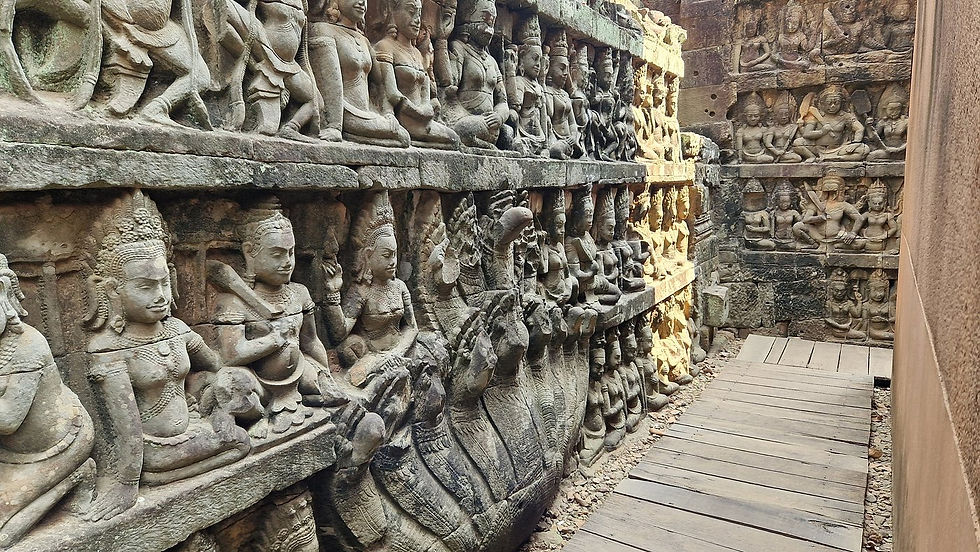The Birth of Apsaras - Daughters of the Ocean of Milk
- Shannon
- Jul 15
- 4 min read
Updated: Jul 28
Apsaras, the celestial nymphs of Hindu and Buddhist mythology, are revered for their unparalleled beauty, graceful movements and mastery of dance and music. Adorned with golden skin, fragrant hair and flowing garments, they appear throughout ancient texts as divine attendants in the heavenly courts of gods like Indra, where they serve as entertainers and symbols of spiritual and aesthetic refinement. In Khmer temple art, most famously at Angkor Wat, their forms are carved in intricate detail, reflecting their importance across South and Southeast Asian cultures. While their depictions vary in style and emphasis, their essence remains consistent. Tthey are divine beings associated with elegance, fertility and the pleasures of the celestial realm. In some Hindu narratives, Apsaras are also portrayed as being sent to distract powerful sages whose spiritual asceticism might challenge divine order, not out of malevolence but as agents maintaining balance within the cosmos.
The origin of the Apsaras is linked to the myth of Samudra Manthan, the churning of the ocean of milk, a pivotal event in Hindu cosmology. This cosmic churning was carried out by the Devas, celestial beings who represented order and light and the Asuras, their shadow counterparts, often associated with chaos, pride and ambition. Together, they used the mountain Mandara as a churning rod and the serpent Vasuki as a rope to stir the ocean, aiming to obtain amrita, the nectar of immortality. As the ocean was churned, various divine beings and treasures emerged, including the Apsaras, celestial nymphs renowned for their beauty, grace, and skill in dance and music. They are regarded as divine attendants who bring joy and entertainment to the gods.

Though they enchant with their grace, Apsaras are far more than mere ornaments of the divine court. Known for their mastery of the arts, they serve as celestial entertainers, often depicted in the heavenly courts of Indra, delighting gods and fallen heroes alike. In some Hindu epics, they are gifted to victorious kings or sages as rewards, symbolising divine favour. However, in certain stories, especially within later literature and Buddhist retellings, their beauty becomes a double-edged sword. Sent occasionally by gods to distract powerful ascetics from their penance, they represent not evil but the seductive pull of pleasure that can divert one from a path of renunciation. In this context, Apsaras are not demonic or deceptive but reminders of the intoxicating nature of sensual experience. They are radiant, ephemeral and capable of turning even the most focused mind toward desire. Their role is nuanced, divine, desirable and sometimes dangerously compelling.

Not all interactions between Apsaras and mortals end in divine reward. One of the most enduring stories is that of Urvashi, one of the most prominent Apsaras and King Pururavas, a mortal ruler of the lunar dynasty. According to the Rigveda (a collection of ancient Sanskrit hymns) Urvashi falls in love with Pururavas and the two live together under strict conditions. He must never let her see him naked except during love and must protect a pair of sacred lambs she cherishes. However, the Gandharvas, celestial musicians who resented her union with a mortal, conspire to sabotage their relationship. One night, they steal the lambs and create a flash of lightning that exposes Pururavas nakedness to Urvashi's gaze. With the conditions broken, she is compelled to return to the heavens. Their love is tragic not because of any punishment or curse but because of the divine laws and fragile boundaries between heaven and earth. In some versions, Urvashi later grants him brief reunions, allowing them to share moments of love across the veil of realms but their bond remains bittersweet, governed by impermanence and cosmic order.
At Angkor Wat and other Khmer temples, thousands of Apsaras are carved into sandstone walls, each figure rendered with unique hand gestures, ornate jewellery and elaborate hairstyles. These celestial dancers hold a prominent place in Khmer religious art, symbolising divine beauty, grace and the spiritual harmony of the universe. Distinct from temple guardians known as Devatas, Apsaras are typically shown in dynamic poses, reflecting their association with dance and music. Their inclusion in temple architecture highlights their cultural and cosmological significance within the Angkorian worldview, where they were seen as auspicious figures connected to heavenly realms and royal authority.

In Hindu tradition, Apsaras occasionally play a disruptive role in the spiritual pursuits of ascetics. Their beauty and charm, while divine, could be used strategically by the gods to interrupt extreme acts of penance that might threaten the cosmic balance. One of the most well-known examples is that of Vishvamitra, a powerful Kshatriya caste king who renounced his throne after a rivalry with the sage Vasishtha and undertook intense austerities to attain the status of Brahmarishi (a sage who has attained the highest spiritual realisation and direct knowledge of Brahman, the ultimate reality). Fearing his rising power, Indra, the king of the gods, sent the Apsara Menaka to distract him. Her success in seducing Vishvamitra caused him to lose the spiritual energy he had accumulated over many years of ascetic practice. Though this episode did not end his quest for enlightenment, it significantly delayed his progress, illustrating the tension between sensual temptation and spiritual discipline in the path of renunciation.

Though their origins lie in mythic waters and divine conflict, these celestial beings have endured across centuries in literature, sculpture and ritual. From ancient Sanskrit hymns to the carved galleries of Angkor, their presence reflects the enduring value placed on beauty as a bridge between the mortal and the divine. Neither passive symbols nor simple entertainers, they occupy a unique space in cosmology as timeless figures who continue to move through art, performance and belief. Their legacy is not just one of elegance but of spiritual resonance carried through cultural memory.
Thanks for reading The Birth of Apsaras - Daughters of the Ocean of Milk. Check out more legends here!










































